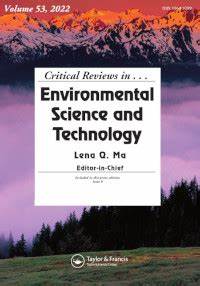Advanced porous nanomaterials as superior adsorbents for environmental pollutants removal from aqueous solutions
IF 13.2
1区 环境科学与生态学
Q1 ENVIRONMENTAL SCIENCES
Critical Reviews in Environmental Science and Technology
Pub Date : 2023-01-23
DOI:10.1080/10643389.2023.2168473
引用次数: 46
Abstract
Abstract Advanced porous nanomaterials such as metal-organic frameworks (MOFs), covalent organic frameworks (COFs), and porous aromatic frameworks (PAFs) with high specific surface areas, abundant functional groups, accessible pore structures, tunable pore sizes, and easy modification are attractive as adsorbents for the capture of toxic heavy metal ions, organic pollutants, and radionuclides from aqueous solutions. This review first comprehensively introduces the attractive properties of MOFs, COFs, and PAFs to highlight their advantages as adsorbents. Subsequently, the recent progress of MOFs, COFs, and PAFs as superior adsorbents for the efficient removal of environmental pollutants is summarized. Furthermore, the influences of environmental conditions and information about the interaction mechanisms between pollutants and advanced porous nanomaterials are discussed. Finally, the applications and promising prospects of advanced porous nanomaterials in environmental pollution management are summarized. This review is beneficial to designing and fabricating advanced porous materials, which also provides some meaningful guidance for studying the adsorption mechanisms between porous materials and environmental pollutants. Graphical abstract先进的多孔纳米材料是去除水中环境污染物的优良吸附剂
先进的多孔纳米材料,如金属有机框架(MOFs)、共价有机框架(COFs)和多孔芳香框架(PAFs),具有高比表面积、丰富的官能团、可接近的孔隙结构、可调节的孔径和易于修饰等优点,是吸附水中有毒重金属离子、有机污染物和放射性核素的吸附剂。本文首先全面介绍了mof、COFs和paf的特性,以突出它们作为吸附剂的优势。综述了mof、COFs和paf作为高效去除环境污染物的优良吸附剂的最新研究进展。此外,还讨论了环境条件的影响以及污染物与先进多孔纳米材料相互作用机制的信息。最后,总结了先进多孔纳米材料在环境污染治理中的应用及前景。这一综述有助于设计和制备先进的多孔材料,也为研究多孔材料与环境污染物的吸附机理提供了一些有意义的指导。图形抽象
本文章由计算机程序翻译,如有差异,请以英文原文为准。
求助全文
约1分钟内获得全文
求助全文
来源期刊
CiteScore
27.30
自引率
1.60%
发文量
64
审稿时长
2 months
期刊介绍:
Two of the most pressing global challenges of our era involve understanding and addressing the multitude of environmental problems we face. In order to tackle them effectively, it is essential to devise logical strategies and methods for their control. Critical Reviews in Environmental Science and Technology serves as a valuable international platform for the comprehensive assessment of current knowledge across a wide range of environmental science topics.
Environmental science is a field that encompasses the intricate and fluid interactions between various scientific disciplines. These include earth and agricultural sciences, chemistry, biology, medicine, and engineering. Furthermore, new disciplines such as environmental toxicology and risk assessment have emerged in response to the increasing complexity of environmental challenges.
The purpose of Critical Reviews in Environmental Science and Technology is to provide a space for critical analysis and evaluation of existing knowledge in environmental science. By doing so, it encourages the advancement of our understanding and the development of effective solutions. This journal plays a crucial role in fostering international cooperation and collaboration in addressing the pressing environmental issues of our time.

 求助内容:
求助内容: 应助结果提醒方式:
应助结果提醒方式:


